Data insights are crucial if you want your business to succeed. Our Custom Reports provide you with access to more in-depth data and greater customizability – all from one place. You can identify connections between different data sets, and get specific details important to your workflow.
1. Getting Started
To get started, first ensure that the Custom Reports Add On is enabled. Go to Settings → Add Ons → Custom Reports. Here, enable the Add On and select the appropriate checkboxes if you’d like to allow users to save and schedule Custom Reports.

Now, once you’ve saved these changes, head to Reports → Custom Reports → Custom Report. You can also click on the ‘Create Report‘ button on the top-right of the Reports page to be taken directly to the Custom Report page.
Here, you can build your Custom Reports from scratch. Before we get into that, take a look at the buttons highlighted below.

- Load Saved Report: Load a report you previously saved. Learn more.
- View Scheduled Report: View any reports you’ve scheduled within this category. In order to schedule a report, you need to first enable the relevant settings from Settings → Add Ons → Schedule Custom Reports. Learn more.
- Export: Download this report as a CSV/PDF, or upload it to your OneDrive/Dropbox. Learn more.
2. Selecting a Module
Start creating your report by selecting a primary module for your report. Here’s a look at the primary modules you can choose for your Custom Report:

The extensive list of options enables you to pull insights for any aspect of your operations. If you want to generate a maintenance report, choose ‘Services’, or select ‘Locations’ to generate a report on your national operations.
Next, select one or more related modules.
These are dependent on your initial selection. For example, choosing ‘Locations’ allows you to choose from related modules such as Items, Location History, Stock Requests, and Work Orders.
Let’s create our very first custom report.
We want to run a report on business assets sent to specific job-sites for different projects. For that, we’ll select ‘Items’ as the primary module. That results in the following related modules:

For the purpose of this report, we’ve chosen ‘Carts’ and ‘Locations’ as the related modules. These choices update the columns available to you in the next step.
Note: Some related modules can have multiple associations with a single item. As an example, one item can be associated with multiple Comments, Documents, and Carts. When setting up a report, you cannot select more than one of these related modules. In the above example, since we chose Carts, the Documents and Comments checkboxes are locked.
3. Selecting Columns
Now, we need to select columns based on all 3 of our chosen modules. To do this, simply select the columns you want to add.

We’re adding in item identifiers, location identifiers and cart fields for our report. We even added a Custom Field (‘Item Project Number’) that was created so we could track projects individually. As always, the Custom Fields relating to each category appear at the very end of that category.
4. Applying Filters
Apply filters to your Custom Report by picking the relevant category, filling in the fields next to it, and clicking ‘Add Filter’. These filter options are also dependent on the primary and related modules you’ve chosen.
We picked ‘Items’, ‘Carts’ and ‘Locations’, so we can add multiple filters based on any of these modules.

Here’s how to add a filter:
- Choose a module and the filter you would like to apply.
- Next, choose between items displaying in an ascending or descending order.
- Click on ‘Add Filter’. This action adds the filter to the list of Applied Filters.
- To add another filter, use the same dropdown to select a new module and filter.
For our report, we’ve chosen a Location filter for Seattle Office, as well as a filter for ‘Checked out’ Carts.

Additionally, you can also apply two or more filters to one module. To stack filters in this manner, choose the same module again with a different filter state, and click on ‘Add Filter’. We’ll try this on our Cart status filter.
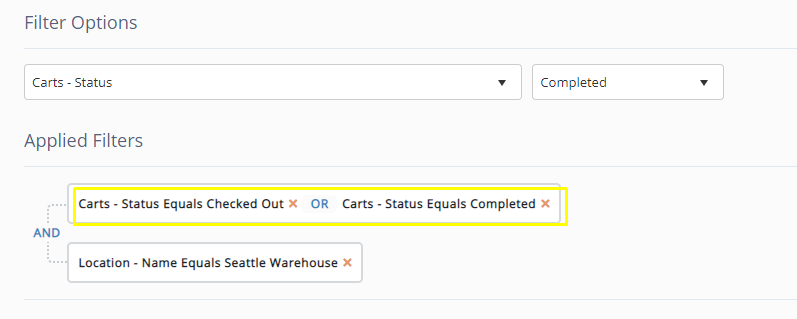
The stacked filters are highlighted in the image above. You can click on the crosses to remove one of the filters, or hit Remove Filter to remove the entire filter.
The ‘And’ ‘Or’ options available between filters enable you to choose how you want to apply the filters. You can change between ‘And’ ‘Or’ for the same item, such as different states of carts. Or you can also choose Carts And Locations or Carts Or Locations for two different items. Simply click on the And/Or option to switch.

You also have the option to switch to Advance View when applying filters.
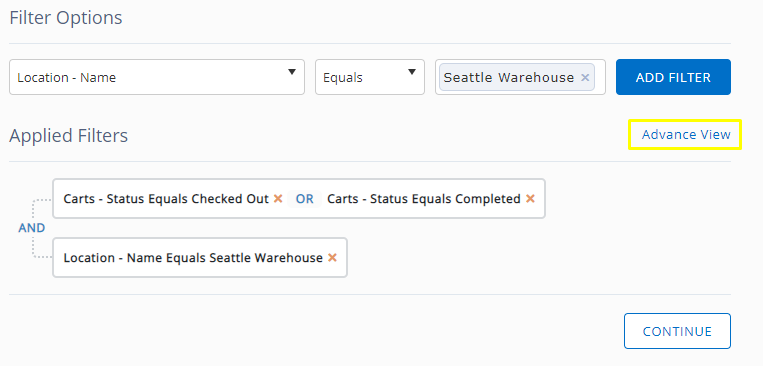
After switching to the Advance View you will be able to drag and drop in groups and use the Filter Criteria to specify logic functions. The filters we chose initially appear like this:
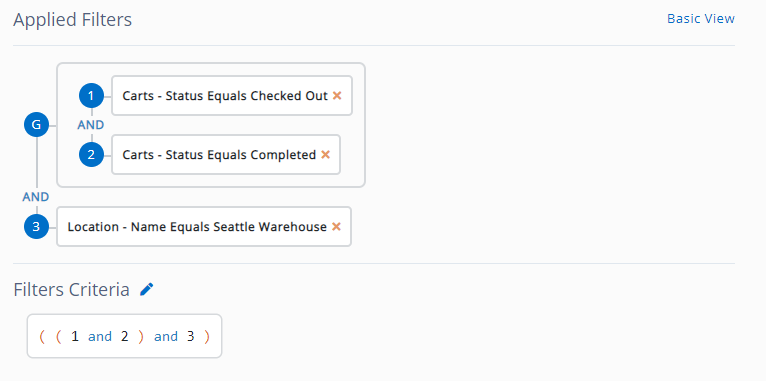
We then drag the Locations filter to the first group. The Filters Criteria also changes to display the change in groups. You can undo this action anytime by the button on the right side.
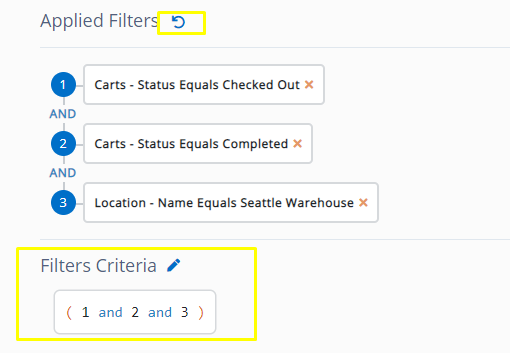
5. Grouping line items in report
You can also group line items to make it easier for you to view and analyze the report. This feature clubs similar items together to improve report readability.
To begin, click on ‘Group rows’ under Step 3. Next, simply make your selections.
We’ll choose to group rows by Item names.

5.1 Group items to show trends across time
The custom reports also allows you to group items by time to see trends over a specific period. By using this filter you can check how many Assets were checked out at a given month, date, year or time. The report will show the Asset count alongside the time period specified
Go to Step 4, here you can Group rows by different time periods to show trends. In the image below, we choose to see Asset checkouts dates over Month and Year:

Let’s say for example you run a Report to see Asset checkouts in each month and time. The Report will look like this:

The same Report can be represented in a graph to clearly show the time trend for Asset checkouts:

5.3 Group line items by date or price range
You can apply the date or price range for line items. Let’s say the admin needs a report of all assets that are priced between $100 to $500. To begin, select Items in Step 1. Next, select the Items-Cost price/Add stock price as a column in Step 2. Then, select the same row in Step 4.

Once selected, click the option ‘+Add Grouping Rule’ to set minimum, maximum value, and interval size. In this scenario, we have set 100 as the minimum, 500 as the maximum, and an interval of 50 between item prices.

Now you can run your report to view all assets between this price range:
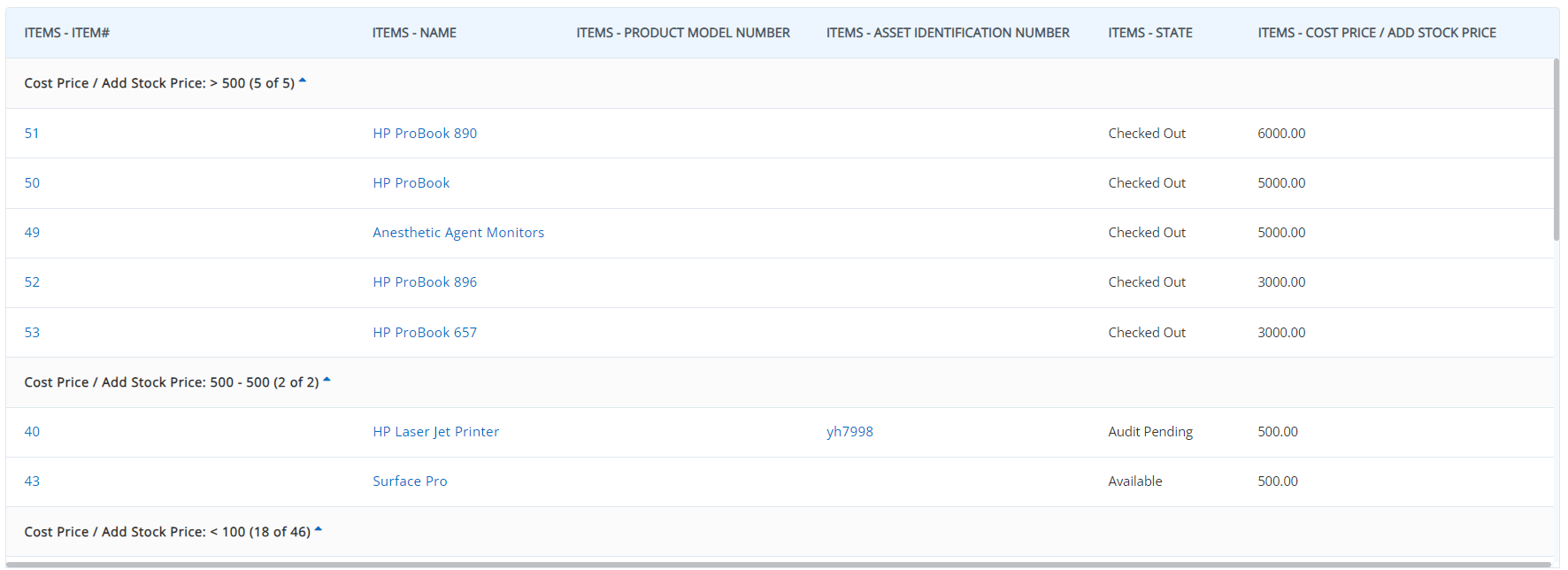
6. Using Functions
You can apply functions to fields in reports to get more insight into your report/data.

As displayed above, you can apply multiple types of functions ie. Count, Sum, Average etc. depending on your requirement.
Note: Functions can only be applied to numeric fields. Therefore the system automatically displays only numeric fields as options for the “Choose Field” dropdown.

For example, we have chosen the field Cost Price/Add Stock Price here and the SUM value that will add the values of multiple entries and provide a total.

You can apply a function to a single field, or apply multiple functions to a single field. Here we have applied two functions, SUM and MIN to a single field Items- Cost Price/Add Stock Price

You can also apply multiple functions to multiple fields. Once you have selected the fields and functions, it’s time to run the report.

This is what a simple report will look like. Please note that if the report is more than one page, the SUM value will show up on the last page of the report.
You can also apply Functions on Groups to generate more layered reports.

In the example above, items are grouped together based on their state. You can keep the rows expanded for more details and collapse them if you don’t need to view individual details.
You can likewise apply Functions to multiple groups or apply multiple Functions to a group.
7. Running Your Custom Report
Once you’re done creating your report, it’s time to generate it!
Click on one of the following buttons, depending on your need:
- Run Report: Generates the Custom Report.
- Save Report: Saves the template for future use. This option is only visible once you’ve run the report.
- Schedule Report: Sends the report to specified people at set intervals.
We’ll run our report now. Here’s what it looks like:

Notice that the same item names are grouped together. You can click on one of the arrows highlighted to expand an entry or collapse it.
8. Creating Custom Report Graphs
After finalizing your custom report, you can run a Graph for visual presentation of your report. Learn here how to run Graphs for your custom reports and export them to the Dashboard.
9. Applying viewing filters
Majority of users create and save custom reports on a monthly or weekly basis. By using viewing filters, users can now sort out saved reports to display certain parts of a report. This helps save time spent in running reports for specific locations or groups again and again. The view filters are even applicable on custom report graphs.
Go to your saved report and click on the Filter icon on the left side.
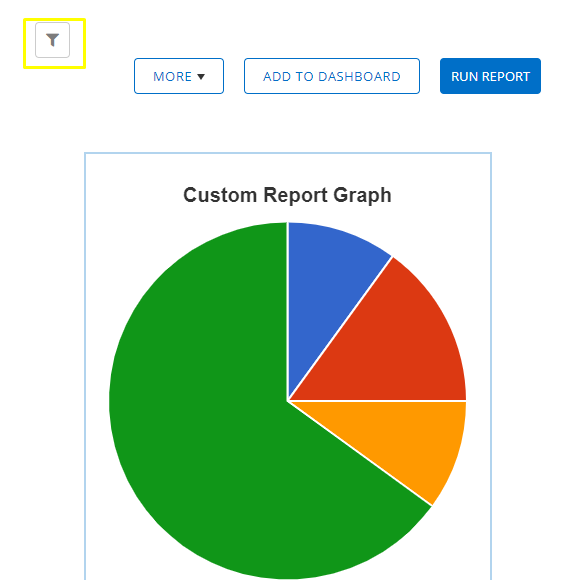
Select the filters you want to apply on your saved report and graph and hit ‘Apply Filters’.
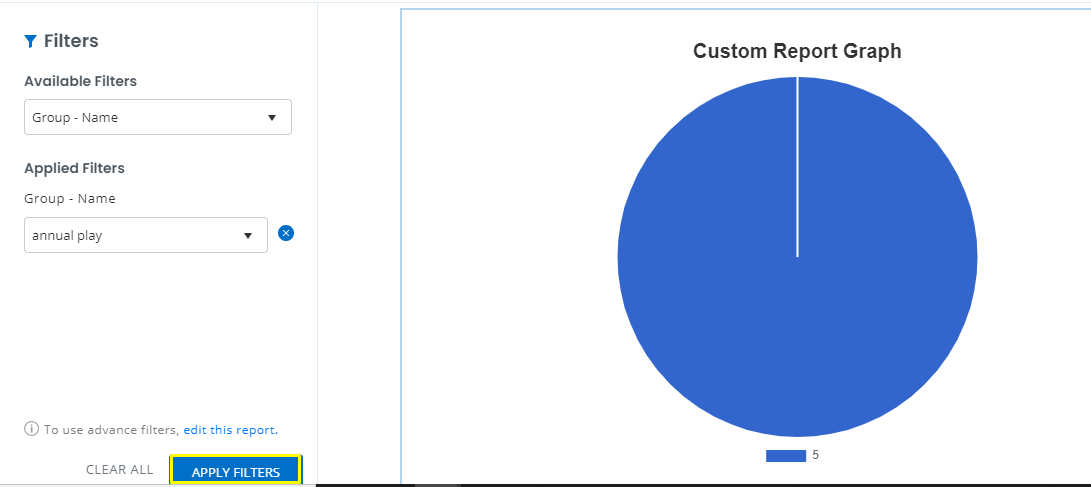
Once the filters are applied, you will be able to see the new Graph and Report according to your requirements.
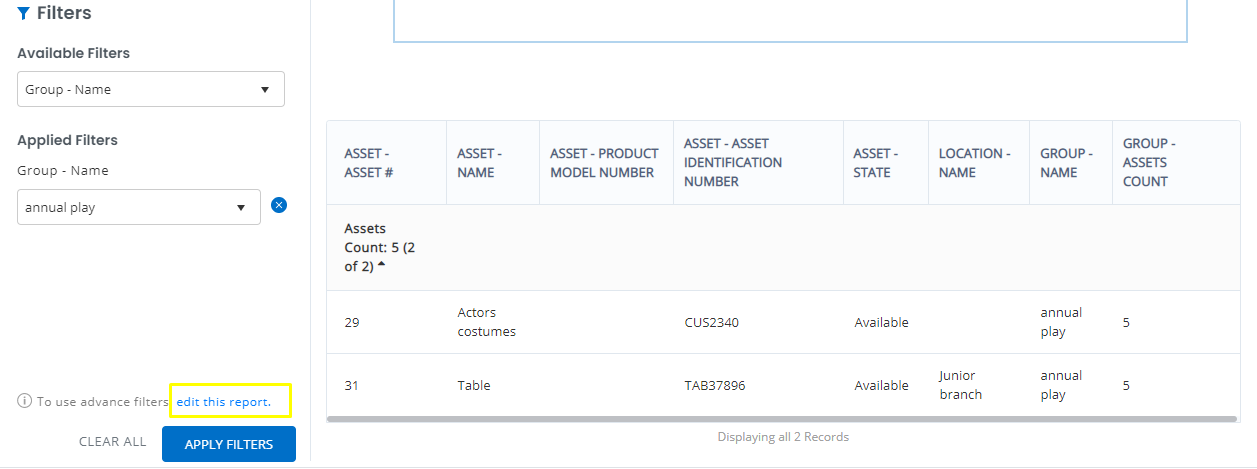
Note: You can edit the saved Report by clicking on ‘edit this report’ at the bottom right on the filter window. This will take you to the main Custom Report page where you can choose additional filters.
10. Exporting Custom Reports
You can export your custom report by clicking on “Export”. You can export in CSV, PDF and XLS formats.

If you are exporting the report in CSV or XLS format then you will be required to choose whether the report is “Formatted” or “Unformatted”.
Here’s how formatted and unformatted reports are different:
- Formatted: This displays all the information in the current view of the report including the groups.
- Unformatted: This displays all the information without any row/ column groupings i.e., allowing the user to export raw data that can be worked on later in the report. This makes the report editable on platforms like excel and makes it easier to do further calculations if needed.
Note: The grouping columns will be added as columns at the end of the report.
11. Summarize Custom Reports
The ‘View Summary’ feature in custom reports provides a precise view of reports and allows users to look at grouped results in the form of aggregate numbers. The summary report is easy to understand and use, making it simpler to work with important numbers.
Note: Users can leverage the feature only if they use the ‘group by’ option while creating the reports.

After creating a custom report, Go to → View Summary.

Here’s a summarized view of items grouped by location and the Total Cost Price associated with each.

If you group the items by name, the summary report will look like this:

Have Questions?
If you have any questions about EZOfficeInventory, feel free to reach out to our support team at support@ezo.io







